Estrategias de trading para respaldar tu toma de decisiones
Explora técnicas prácticas para ayudarte a planificar, analizar y mejorar tus operaciones.


Most traders understand EA portfolio balance through the lens of traditional risk management — controlling position sizes, diversifying currency pairs, or limiting exposure per trade.
But in automated trading, balance is about deliberately constructing a portfolio where different strategies complement each other, measuring their collective performance, and actively managing the mix based on those measurements.
The goal is to create a “book” of EAs that can help diversify performance over time, even when individual strategies hit rough patches.
A diversified mix of EAs across timeframes and assets can, in some cases, reduce reliance on any single strategy. This approach reduces dependency on any single EA’s performance, smooths your overall equity curve, and builds resilience across changing market conditions.
It’s about running the right mix, identifying gaps in your coverage, and viewing your automated trading operation as an integrated whole rather than a collection of independent systems.
Basic Evaluation Metrics – Your Start Point
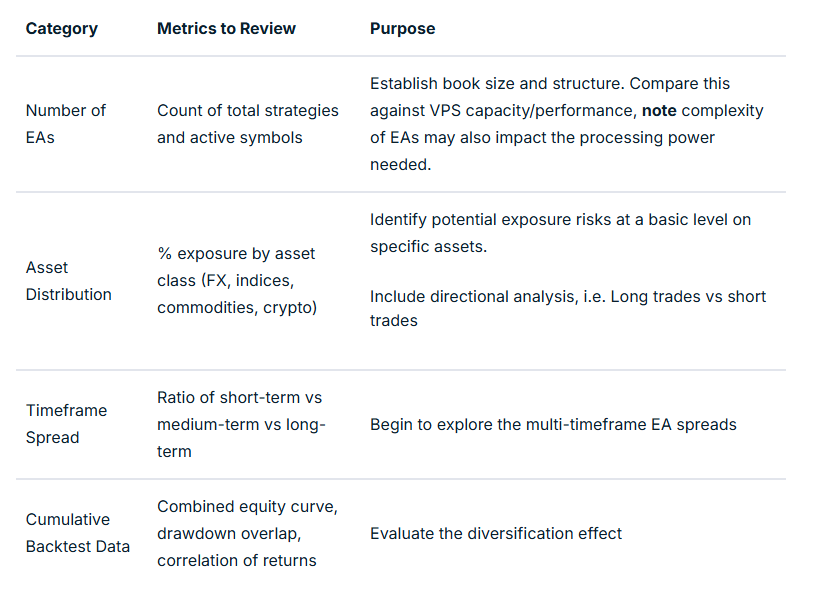
Temporal (timeframe) Balancing
When combined, a timeframe balance (even on the same model and instrument) can help flatten equity swings.
For example, a losing phase in a fast-acting M15 EA can often coincide with a profitable run in an H4 trend model.
Combining this with some market regime and sessional analysis can be beneficial.
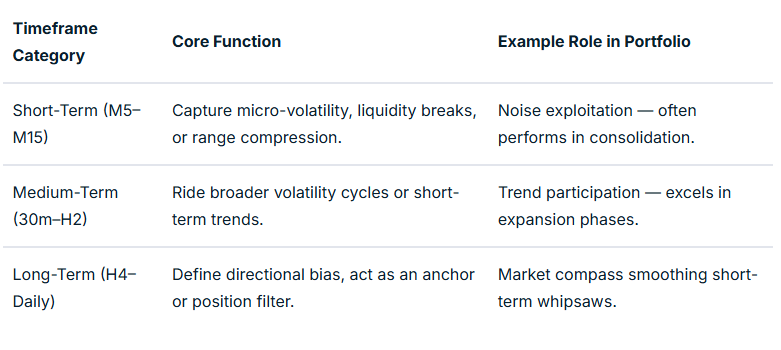
Asset Balance: Managing Systemic Correlation Risk
Running five different EAs on USDJPY might feel diversified if each uses different entry logic, even though they share the same systemic market driver.
But in an EA context, correlation measurement is not necessarily between prices, but between EA returns (equity changes) relating to specific strategies in specific market conditions.
Two EAs on the same symbol might use completely different logic and thus have near-zero correlation.
Conversely, two EAs on a different symbol may feel as though they should offer some balance, but if highly correlated in specific market conditions may not achieve your balancing aim.
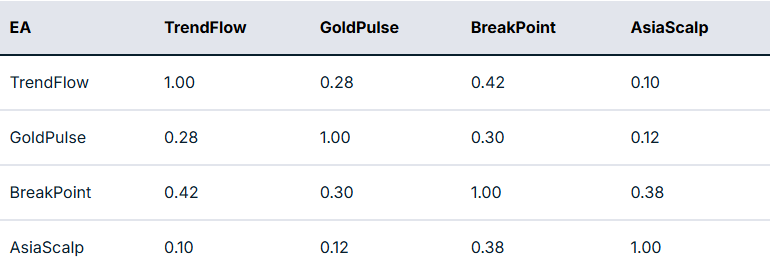
In practical terms, the next step is to take this measurement and map it to potential actionable interventions.
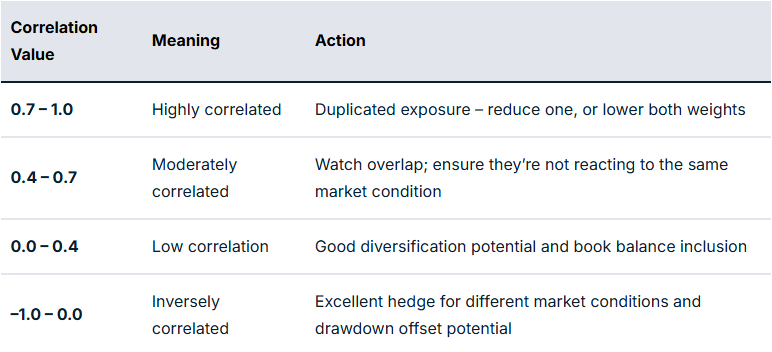
For example, if you have a EURUSD Trend EA and a GBPUSD Breakout EA with a correlation of 0.85, they are behaving like twins in performance related to specific market circumstances. And so you may want to limit exposure to some degree if you are finding that there are many relationships like this.
However, if your gold mean reversion EA correlates 0.25 compared to the rest of your book, this may offer some balance through reducing portfolio drawdown overlap.
Directional and Sentiment Balance
Markets are commonly described as risk-on or risk-off. This bias at any particular time is very likely to impact EA performance, dependent on how well balanced you are to deal with each scenario.
You may have heard the old market cliché of “up the staircase and down the elevator shaft” to describe how prices may move in alternative directions. It does appear that optimisation for each direction, rather than EAs that trade long and short, may offer better outcomes as two separate EAs rather than one catch-all.
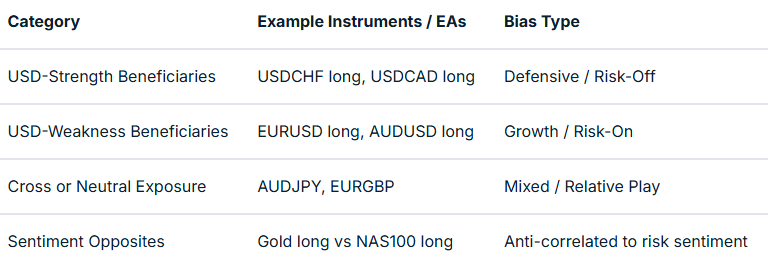
Market Regime and Volatility Balance
Trend and volatility states can have a profound impact on price action, whether as part of a discretionary or EA trading system. Much of this has a direct relationship to time of day, including the nature of individual sessions.
We have a market regime filter that incorporates trend and volatility factors in many EAs to account for this. This can be mapped and tested on a backtest and in a live environment to give evidence of strategy suitability for specific market conditions.
For example, mean reversion strategies may work well in the Asian session but less so in strongly trending markets and the higher volatility of the early part of the US session.
As part of balancing, you are asking questions as to whether you actually have EA strategies suited to different market regimes in place, or are you using these together to optimise book performance?
The table below summarises such an approach of regime vs market mapping:
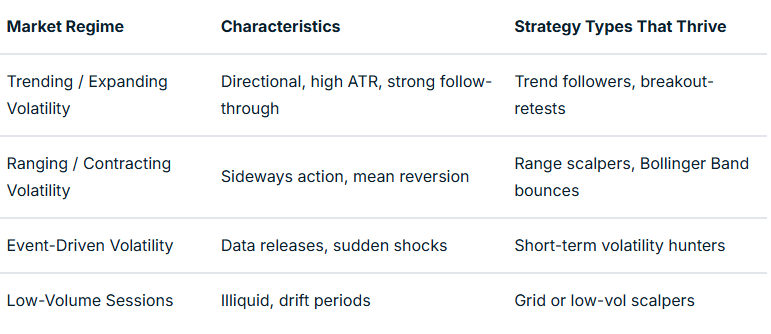
Multi-Level Analysis: From Composition to Interaction
Once your book is structured, the challenge is to turn it into something workable. An additional layer of refinement that turns theory and measurement into something meaningful in action is where any difference will be made.
This “closing the circle” is based on evidence and a true understanding of how your EAs are behaving together. It is the step that takes you to the point where automation can begin to move to the next level.
Mapping relationships with robust and detailed performance evaluation will take time to provide evidence that these are actually making a difference in meeting balancing aims.
To really excel, you should have systems in place that allow ongoing evaluation of the approaches you are using and advise of refinements that may improve things over time.
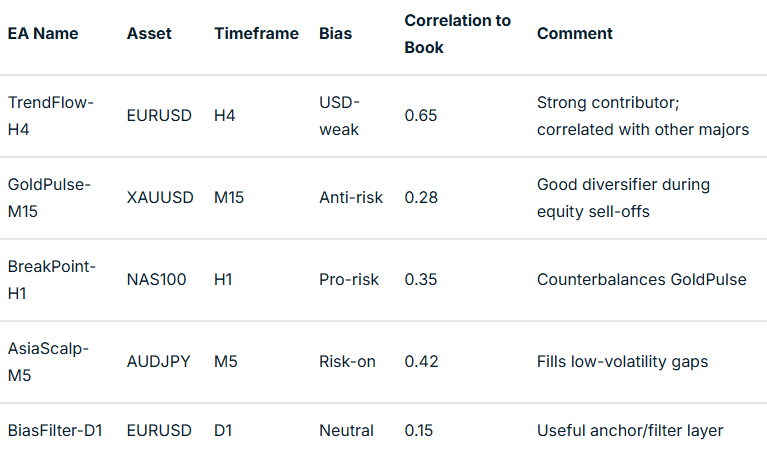
What Next? – Implementing Balance in Practice
Theory must ultimately translate into an executable EA book. A plan of action with landmarks to show progress and maintain motivation is crucial in this approach.
Defining classification tags, setting risk weights, and building monitoring dashboards are all worth consideration.
Advanced EA traders could also consider a supervisory ‘Sentinel’ EA, or ‘mothership’ approach, to enable or disable EAs dynamically based on underlying market metrics and external information integrated into EA coding decision-making.
Final Thoughts
A balanced EA portfolio is not generated by accident; it is well-thought-out, evidence-based and a continuously developing architecture. It is designed to offer improved risk management across your EA portfolio and improved trading outcomes.
Your process begins with mapping your existing strategies by number, asset, and timeframe, then expands into analysing correlations, directional bias, and volatility regimes.
When you reach the stage where one EA’s drawdown is another’s opportunity, you are no longer simply trading models but managing a system of EA systems. To finish, ask yourself the question, “Could this approach contribute to improved outcomes over time?”. If your answer is “yes,” then your mission is clear.
If you are interested in learning more about adding EAs to your trading toolbox, join the new GO EA Programme (coming soon) by contacting [email protected].


What Is The Art Of War? The Art of War is an ancient Chinese book on military tactics and strategy who written by Sun Tzu around 500 BC. These writings are considered by many to be the most significant literature on military tactics and wisdom that can be applied to everyday life ever conceived.
In this multi-article series, we will be interpreting this ancient text, and exploring its application to modern day investing and trading. The whole book has 13 chapters and is only 6,000 characters long, which is relatively concise for such an old and complex language. I will be breaking this down into sections, explaining the meaning behind each phrase and how to apply this to your trading style or strategy.
Military Style Trading Imagine this. You're sitting in front of your screen opening a candlestick chart and trying to figure out the recent patterns and getting ready to place an order. What if you viewed this chart like a military map?
The money in your account is like the soldiers under your command, and the buy or sell orders are like attack or retreat orders. Can you see what I'm hinting at here? —— Trading and War tactics are both arts and similar in many ways. So why don’t we try absorbing some knowledge from the ancient masterpiece?
Perhaps we'll discover some inspirational gems that we can use in our approach to the financial markets. Chapter 1: Strategy Tips: As we progress through the following sections, whenever you see the word “War,” try to replace it with either “Investment” or “Trading” in your head. Explanation: In ancient society, the theory was those who fail to consider strengthening their military force will die.
Nowadays, modern society suggests if you ignore investment principles, you will also die, not physically, but perhaps perish in mediocrity. For example, we all know that since 2008, the wealth inequality gap has become much worse. A vast number of billionaires have emerged, while the middle classes are considerably poorer than one decade ago.
Different Class Different Mentalities One possible explanation behind this is because most rich people tend to invest their money into the stock market or high yielding assets in contrast to the general middle-class who's mentality is geared towards savings and consumption. If Sun Tzu were around today, he'd likely suggest investments over savings. The reason for this is because investing can amplify your wealth if managed correctly, but the method of saving money could be considered a slow death.
Death By Inflation In short, cash in the bank is devalued over time by the act of inflation. While saving money is not necessary a bad thing for some, failing to learn about investing might mean sacrificing opportunities or degrading one's wealth as its value inevitably starts to erode on the sidelines. (1) Tao Explanation: Tao could represent the basic, intrinsic rules of each investment product. For example, the movement of a currency pair (say GBPUSD) is often affected by the fundamentals, news events (such as Brexit) or even just human behavior.
So how can we trade the intrinsic values as the price is always changing? The answer is to find specific patterns or characteristics that are inherent to whatever product you are trading. To do this, you need to explore all the elements and try to make an informed decision as to the possible move in price.
However, given nobody can predict these moves with 100% accuracy, perhaps the only thing we can do is use the following four factors as a guide to help eliminate bad trading habits, and increase the probability of executing profitable trades. (2) Time You can think of this second factor as Fundamentals. As a qualified investor, you should understand what economic data means (such as GDP growth, unemployment, CPI, etc.), What types of events could cause the price to rise and fall (for example you should know how Bond-yield affects the value of USD) As with the cyclical nature of seasons or knowing the exact time of the sunrise and sunset, fundamentals can provide clues as to when we should place a trade based on the upcoming data. This idea is just like a weather forecaster predicting the chances of rain tomorrow.
Keep in mind that the weather, like markets, is not an accurate science and is subject to change. (3) Earth Ea rth or Topography would represent the field of Technical analysis because this method explores the “landform” of a price chart. For example, the highs and lows are like highlands and lowlands in battlefields, with support and resistance lines acting as potential grounds to set up an ambush or mount a defense. By mastering technical analysis, you will be like a commander, studying the geographical features of a map, navigating the terrain and using this knowledge to plan an attack or send reinforcements.
I will use a straightforward chart to illustrate all the factors that mentioned in Sun Tzu's original text. From the chart below, we can see the trend of oil prices is going up, and the most obvious move is to look for an area of value. The idea is to place a buy order while the level is relatively low.
When the price approaches the trend line, perhaps this is a safer place an order? On the other hand, when activity reaches the upper band, in the context of Sun Tzu, it might be considered “too far and dangerous” to keep attacking; thus the best move is to retreat (close your position and take your profit). We'll be discussing more on topography and technical analysis in further chapters. (4) Commander A commander (i.e., investor) should aspire to obtain the characteristics listed above.
If any of these traits are missing, Sun Tzu would perhaps suggest you are more vulnerable to trading losses in the future. Thus, Investment is also a process of exercising yourself to become a better person. (5) Discipline Discipline involves organizing a set of rules to follow while trading and the text would suggest you should not change these on a discretionary basis. Similar to military orders on a battlefield, it is imperative a commander's orders are followed and not disobeyed.
In short, without discipline and proper execution, the fundamental and technical analysis that you apply above will be meaningless. By Lanson Chen - Analyst Lanson Chen @LansonChen This article is written by a GO Markets Analyst and is based on their independent analysis. They remain fully responsible for the views expressed as well as any remaining error or omissions.
Trading Forex and Derivatives carries a high level of risk. Sources: DB Global Markets Research, "The Art Of War" -Sun Tzu.


One of the worlds most profitable Hedge Fund Managers Paul Tudor Jones called it in Tony Robbins Money Master Book " my #1 Trading indicator " and some of my colleagues in institutions and banks have referred to it as a key barometer for where substantial money flow often occurs. I am referring to the 200-Day Moving Average on a Daily chart and as the charts will demonstrate below the 200 MA (moving average) not only has the potential to reverse a currency market but can also be a general guide to where the overall trend is. So how can you use the 200 MA to potentially improve your strike rate in the currency markets?
It is generally viewed by most professional traders that if price is above the 200 MA they will not attempt to short a currency and will generally only look to use their trading system to buy into the market they are trading. The opposite when price is below the 200 MA, they will generally look to only short the currency pair they are trading. Trading systems that appear to have an edge on a higher time frame such as a 4-hour or daily chart can potentially be enhanced by applying this rule of thumb.
Following are 4 charts showing the 200 MA on a Daily Chart. If you’d like to apply a 200 MA to your MT4 platform simply go to the Menu at the top of the page, click on Insert, then click on indicators and then trend. You will see Moving Average listed there for you to click on and load.
Make sure you input 200 into the Period box under Parameters. Andrew Barnett | Director / Senior Currency Analyst Andrew Barnett is a regular Sky News Money Channel Guest and one Australia’s most awarded and respected financial experts, and is regularly contacted by the Australian Media for the latest on what is happening with the Australian Dollar. Connect with Andrew: Email


As a trader, you’ve probably found that having the right trading plan plays a significant role in your trading success. A basic trading plan should tell you what, when and how much to trade. It should also have specific instructions on when to close out your trades.
As traders, we all need a well thought out trading plan to navigate our way through the turbulent waters of financial markets, with the added benefit of having something to hang on to when we’re in the middle of a trade. Devising a trading plan needs detailed analysis and careful consideration. Unfortunately, we are not able to go through how to develop a complete trading plan in a short article such as this.
However, we are going to discuss some fundamental points to assist anyone who already has a trading plan or is in the process of developing one, helping to make sure it includes these minimum standards. 1. A trading plan that suits your character In any trading plan lies a trading philosophy that determines the overarching framework. The trading philosophy represents your beliefs about the markets.
For example, it shows whether you believe in short-term technical trades, or if you think success can be achieved by making long-term fundamental trades. It shows if you are a trend trader looking to move with the flow of the market, or if you are contrarian in nature and are looking for opportunities to go against the others. Regardless of the trading philosophy you choose, our suggestion is to make sure that it A) is proven and valid, and B) suits your personality.
If the trading philosophy does not suit your character and the way you look at the markets, you will inevitably deviate from your plan and potentially put yourself in a difficult situation, both financially and psychologically. Once you are confident that your trading philosophy is appropriately reflected in your trading plan, your plan should be capable of delivering and managing desired trading opportunities in the context of your trading philosophy. To achieve this, you need to make sure all the below requirements are met as a bare minimum. 2.
Your trading plan should be bias-free Biases occur because we have pre-set ideas in our minds that stop us from making objective decisions. This problem lies within human nature and is the result of our emotional and cognitive limitations. Within the long list of biases that exist, there are two which are the most harmful to many traders: confirmation bias and hindsight bias.
Confirmation bias is when we systematically look for what confirms our prior beliefs and ignore most evidence that challenges our set preconceptions. An excellent example of this bias is when we are trying to ascertain a simple breakout strategy by looking at a chart, a strategy used by many traders to trade the news. If the market keeps going in the direction of the breakout, we gladly count it as a success (after the fact), but if it fails — that is, it reverses its course after the breakout — we call it a Bull/Bear Trap and forget about the failure which has just happened.
By renaming the model, we have shifted our attention from a failed breakout strategy to a now successful Bull/Bear Trap! Under the influence of the confirmation bias, we are likely to pursue trading patterns which otherwise would have had little to no merit. This bias makes us derive conclusions that we’d like to see, instead of seeing what’s actually happened in reality.
The second most crucial bias traders face is the hindsight bias. Hindsight bias is when we look at a chart and find ourselves counting easy trades that would have worked well in the past. It is the moment that you go “it was an obvious head and shoulder” after seeing what had happened afterwards.
This bias comes from our tendency to distort our judgment towards the successful event. If you are given a set of questions about uncertain events (i.e. is the market going to consolidate, trend, reverse etc…) and the correct answer at the same time, it is very likely that you would distort your analysis to conclude in line with the correct answer, as if it really was obvious. Hindsight bias makes trading look easy, and can trick you into believing in trading rules and your ability to forecast – either of which may not be accurate.
If your trading plan has seemingly worked well on historical data but is failing to deliver desired results in real time, then it may be suffering from the above biases. Biases must be removed from your trading plan in order for it to be objective and testable. 3. Your trading plan should be objective An objective trading plan can enable traders of different market views to arrive at the same trading decision.
It has enough details and instructions that it takes any confusion out of trades and leaves no room for personal judgment. For example, a good trading plan does not allow traders to draw any trend lines they see fit, but instead, it dictates the trend line which is appropriate to be drawn. It has as many detailed guidelines as possible to stop traders from improvising. 4.
Your trading plan should be testable The best way to make sure your trading plan is objective and bias-free is to convert it into a set of clear trading rules and let a computer test the trading plan for you. This is called backtesting. By using a computer to do the testing, you are essentially removing human emotions and biases from the equation.
Often during the backtest, you will get a much better understanding of the strengths and weaknesses of your trading plan. The downside to backtesting is that it is not easy (it requires coding), and validating a backtested result requires some maths and statistical skills to avoid being trapped by the backtest itself. However, this is still one of the better and cleaner ways to ascertain the validity of your trading system. 5.
Information about the market you are trading The trading plan must hold enough historical information about the performance of the patterns and behaviours of markets you are looking to trade. Whilst the type of the information required depends on the trading strategy, below are a few suggestions that we think should be present in any trading plan that is based on intraday charts: Average size and duration of price swings per trading session Average range per trading session Times of major turning points per trading session Correlations between various trading sessions Historical reactions of the currency to news announcements Important pivots and trends Technical indicators that have worked best over recent history Historical reaction to the session opening and closing times Volatilities per trading session (this can be used to set dynamic stop losses) Intraday correlation with other markets The above should be modified based on your trading strategy. Note that the more you can do to add to the list above, the more confidence you can have in your trading plan. 6.
A solid risk management plan Many of us believe that “stop losses” are the same as risk management. The truth is, stop losses are an essential part of a risk management plan, but are only an element of appropriate risk management. A good risk management plan should have three parts: Tradable instruments: Sometimes you may need to leave a specific currencies/indices out of your tradeable universe just because they can’t justify the risks you will have to take to trade them.
On the other hand, you may at times need to add a few instruments to your universe in order to reduce your risk and maximise your return. You should be able to refer to your risk management plan for these types of questions. Trading size: Your risk management plan should be able to tell how much to trade each time.
It must have a mechanism in place to make sure one or two bad trades do not impact the integrity of your account. Stop losses: Your risk management plan should make sure that your stop losses suit the trading strategy you’re pursuing. For example, a trend trading system may require having close stop losses, whereas this might not be the case for a mean-reverting strategy.
Stop losses should be adaptable to market changes and should be backtested and validated during the testing process. Conclusion: Trading plans are vital for trading success. They have many parts which should be carefully designed and tested.
We appreciate that contemplating all the above points can be challenging and time consuming, however you will become more confident in your trading as you will have in place a structured and improved trading plan.


Annihilation of the Yen It was the year 2013. Some interesting events took place that caused some reverberations in global markets. The once one booming city of Detroit (known for its car manufacturing) filed for bankruptcy and the US government shutdown for almost two weeks.
But the most significant story was the fall of the Japanese currency against all its major counterparts. A dangerous climb In 2013 the value of the Yen fell 21% against the US dollar, making it the most sizeable yearly gain against the Asian currency since 1979. Whenever a currency pair rises or falls this quickly, traders have a tendency to become complacent and think it will continue regardless.
If we’re looking for an analogy, we can view the rise of the US dollar and other currencies to lofty heights against the Yen as something similar to an inexperienced or over-zealous climber attempting to reach the top, but failing to plan for future events and construct a safe passage back down. Resurrection of the Yen Despite the Japanese government’s best efforts – adopting negative interest rates and championing an aggressive stance to help weaken their currency – the Yen has gained both in strength and popularity in 2016. And this is creating some significant moves in the FX world.
Before we discuss the technical side of the charts, it is worth noting that all the Japanese pairs mentioned are currently following a bearish resistance line (BR) or downtrend according to the latest point and figure analysis. Finding 300+ pip moves In the previous newsletter introducing point and figure, we discussed why this method is an excellent tool for locating key areas of support and resistance. The recurring Yen pattern we’ve identified here was discovered using point and figure.
It suggests some long-term moves that could be over 300+ pips in total. The freefall pattern The pattern itself if is quite simple. It appears as if the sharpest JPY declines of 2013 are now becoming the largest JPY rallies of 2016.
Consider the climbing analogy, the latest price swings and resulting patterns are the climbing equivalent of forgetting to place anchors in the cliff face in preparation for the abseil back down. When we study the charts, there are simply no immediate signs of support or footholds that the pairs can target leaving them vulnerable to a potential freefall. As the same pattern is discussed over multiple pairs, we can analyse this into three sections: » Completed » In-progress » Emerging.
Completed Pattern - CADJPY Click to enlarge In a previous CADJPY article, we discussed the importance of the triple bottom located at the 90.00 level and the distinct lack of support below. This is the first example of the pattern of what might happen to some of these JPY pairs once key support levels are breached. No doubt the pressure of global oil prices on the Canadian dollar helped accelerate this move.
As we can see from the chart above, the CADJPY fell to our longer-term target of 80.50 before finding adequate support. The pattern almost resembles a window where price drops significantly to the previous level of demand. This pair may be consolidating now, especially looking at the most recent price action.
While the key level of 80.50 may continue to act as a strong support, resistance to the upside appears to be located at 84.00 and 86.50. In-progress pattern – USDJPY, GBPJPY USDJPY Click to enlarge We also discussed the latest USDJPY move in a recent article and currently we have a longer-term target price of 109.50. Clearly the break of the spread triple bottom at 116.50 was when this pattern activated and the price dropped from 116.50 down to 112.50 creating a 400 pip move.
The pair has since recovered but the main point to take note of is the recent change from an uptrend following a bullish support line (BS) to a downtrend following a bearish resistance line (BR). The level of 114.50 has established as short-term resistance and above here 116.50 may attempt to cap any bullish plays. GBPJPY Click to enlarge Similar to the USDJPY pair, we can see the pattern is in progress here with a downside target of 159.00 where a previous triple top is found.
The trigger point for this move was when the price broke through the spread double bottom at 165.00. Certainly one of the weakest currencies at the time of writing, the Pound has been one of the worst affected by the sudden surge in strength of the Yen. With the looming threat of a ‘Brexit’ (Britain exiting the Euro zone) towards the end of June this year, things may end up going from bad to worse for the GBPJPY pair.
Emerging pattern– EURJPY, NZDJPY, AUDJPY EURJPY Click to enlarge The last group, which we believe has the potential to move in similar fashion to the completed CADJPY pair, is sitting around key support levels which are beginning to look slightly exposed to the downside. The EURJPY has recently produced a sell signal after breaching the 125.50 level. If we look at the chart, there appears to be a glimmer of support around 124.00, but a longer-term target of 120.00 would be the more obvious choice.
The pair has had a rocky road on the way down so far perhaps this would be one of the most stable shifts down if the pattern continued. NZDJPY Click to enlarge The potential NZDJPY setup looks to be one of the cleanest examples of this freefall window pattern. During the past couple of weeks, price action has danced around the key support level 75.00 which is also a spread double bottom.
If this area fails to hold, the next longer-term support and initial target would be 69.00 at this stage. AUDJPY Click to enlarge Although closely related to the NZDJPY pair, the Australian counterpart AUDJPY doesn’t seem to belong to this group. Of course, the potential is still clearly visible on the chart between the levels of 80.00 and 75.00, but the Australian dollar may be more resilient based on recent events and previous price action.
In summary, the pattern itself is not unique. If you follow point and figure, you will notice similar setups on various trading products from time to time. What makes it interesting is that it appears to be happening on nearly all the Yen pairs simultaneously.
The completed pattern on the CADJPY went directly to the nearest support which was almost a thousand pips away. But do not be fooled by the process. Remember these are generally long-term set-ups and without any obvious signs of support, the market may gravitate towards round numbers with psychological importance or become less reliable in general.
There is also an alternate scenario whereby the Yen finds a bottom at current market levels and some of these key areas of support hold, perhaps providing a springboard for price action in the coming months. This also could present an opportunity to find some reasonable risk/reward trades. If you would like to keep up-to-date follow on Twitter or through the GO Markets technical analysis section.
The opinions and information conveyed in the GO Markets newsletter are the views of the author and are not designed to constitute advice. Trading Forex and CFD's is high risk. Adam Taylor | Senior Analyst Adam Taylor joined the GO Markets' team in early 2013 and has gone on to become a valued analyst on our Research and Trading team.
Adam's key strength lies in his technical analysis skills, perhaps honed over his time as a Champion Chess player for his native Scotland. While Adam's primary role is concentrated towards risk management for GO Markets, he's a regular contributor to our News and Analysis team, using the highly regarded but rarely used, point and figure method. Connect with Adam: Twitter | Email | Adam's posts


People often ask me how they can get an edge over other traders in the currency market. My simple answer is this. Study financial market history and it will greatly enhance your profit opportunity because Forex markets will highly likely react the same way each time based on how they reacted last time.
Human beings are what drive all financial markets and as a whole the big money is reasonably predictable in what it will do. It will likely do the same is it did last time when a similar event occurred. Take for example the Yen, which has risen some 17% in 2016 as the BOJ has tried to lower its value by printing more money and putting interest rates into the negative.
Each time the BOJ announces more of the same (money printing & bond and stock buying) the forex market buys more Yen. This is one of the reasons why you have to be in this business for the long haul because the longer you are in the business the more you learn about the history of how the forex market behaves. The average trader often doesn’t want to do the time and they want the profits quickly without doing the forex trading apprenticeship that is required.
This does not mean sitting in front of a computer for hours a day it simply means reading for 15 or 20 minutes a day about why price is moving. The chart is NOT making the price move, the news is making the price move and the chart is simply a reflection of how traders have interpreted the news and bought up or sold off a currency. Join with me and become a detective of forex trading and you will highly likely enhance your profit making potential.
You can join me every Wednesday evening at 7pm AEST for a free one-hour live currency coaching session. Simply click on this link to join the session. http://gomarkets.webinato.com/room1 Andrew Barnett | Director / Senior Currency Analyst Andrew Barnett is a regular Sky News Money Channel Guest and one Australia’s most awarded and respected financial experts, and is regularly contacted by the Australian Media for the latest on what is happening with the Australian Dollar. Connect with Andrew: Email


As a serious trader, one of the key areas you must work on is to develop an awareness of the way the market affects your mind, and subsequently the decisions you make whilst in a trading situation. What are trading biases? People have inbuilt set of belief and value systems that develop over the years through learning and instruction from others and experiences.
Many of these developmental factors are outside the trading context but when the trader interacts with the market, these individual natural ways of thinking and feeling become part of decision-making. Some of these natural in-built responses may not serve you well and are termed ‘cognitive biases’. In many instances in the ‘heat of the action’ when in OPEN trades, these ‘cognitive biases’ take over from your written and planned ‘trading system’ and become the major influence on your market behaviour.
Results that you may produce from your trading can reinforce these in-built biases making them more acute, and so have and ever-increasing influence on what you may do when in the market, until finally they potentially end up destroying the capital and also confidence of the investor. There are several of these outlined in the “behavioural finance” research literature and we intend over a series of articles to look at the more commonly described of these. Loss aversion A loss aversion bias is arguably one of the more common trading cognitive biases.
The trader has an overt focus on avoiding taking a loss in a trade. Obviously, taking a loss, with of course risk management to limit any such loss to a tolerable level (often 2-4% of trading account size) is an accepted reality of trading practice. However, in those with a loss aversion bias, there are two potential behavioural responses when in an open trade that may be damaging to capital and ultimately sabotage the potential for on-going successful trading outcomes. 1.
Stop losses are often moved downwards in a long position (and upwards in a short position) from that originally planned on entry. This is an attempt to regain a losing position with the hope that a price may move back in your desired direction. There may be multiple such “moves” of that stop, each potentially inflicting more damage on capital way beyond any planned maximum risk level.
Commonly, there will be an internal dialogue to justify staying in a trade. 2. Conversely, so potentially acute is the fear of losing a profitable trade that such trades are often exited prematurely throwing out of the window any pre-planned profit target or trailing stop system articulated within your trading plan. The internal dialogue we have occasionally heard form traders is “you will never go broke taken a profit”.
So, in practice these two factors result in a reversal of the traditional market wisdom of ‘keeping your losses small and letting your profits run’, in that losses are extended, and profits are cut short. The basis of such a bias maybe be multi-fold, including: • Previous losses in investments, • Lack of education and confidence, • Over-confidence in your ability beyond competence with a view that a loss in a trade meaning you were “wrong” (an underlying feeling of “I am better than that”), • Pre-set beliefs about how the market SHOULD move i.e. trading what you think not what you see, • taking on the “trades of others” without due diligence and perhaps against your plan (e.g. in forums, trading rooms), • Incorrect position sizing with a small initial trading capital where the effect of trading fees is more acutely felt. And it can get worse… One of the MAJOR problems with a loss aversion bias is that it becomes cyclical in its severity, as results continue to fall short of what you had hoped.
This is not only with individual trades where losses may become more extended and even smaller than possible profits taken. Desperation may eventually set in, with an obsession to get trading capital back, whilst account value continues to diminish until the trade reaches a point of “no more pain” and leaves the market completely. This unfortunately has double impacts - not only has there been a loss of a trading capital now, but in many cases have been sufficiently painful that the individual may never again return to trading (so eliminating any potential for future positive investment experiences).
What you can do If this resonates with you, then the purpose of this article is fulfilled, as recognising and “owing” that there is something that needs to be addressed is the VITAL first step in making a change. Obviously, there are steps you can take to address this (and you MUST). Here are some suggestions: a.
You have a complete trading plan that articulates trading actions once in trades i.e. an exit strategy. b. Start a journal. Sometimes the very process of formally recording what you are doing helps in doing the right thing more consistently. c.
Press the “reset button” on your trading account. What we mean by this is an acceptance that your trading capital is what it is now. Rather than a mission to regain your initial capital this needs to be replaced by a drive to achieve consistently positive trading results (and including that taking a loss within your tolerable level is a positive outcome).
The long-term reality is that through changing this focus as described, addressing the bias through developing that consistency in action, you could give yourself the chance for some sustainable results. d. Re-align with your trading plan prior to every trading session. e. Make it a mission to “challenge” your existing plan on at least a 3-monthly basis through gathering an increased weight of evidence that its component parts are working for you as an individual trader.
This breeds confidence in actioning a plan, enabling more disciplined trading. f. There are a couple of ‘unhealthy’ statements that fly around the investment world which you need to check to not become part of your thinking. The first, “do not invest with money you can’t afford to lose” although is from a well-meaning perspective, arguably can contribute to a mindset which gives some sort of permission to lose.
The second and more dangerous from a capital perspective is “it is not a loss until you take it”. This is a massive distance away from what is recognised as good trading practice and is completely contradictory to the positive idea that you should take a loss as soon as it hits your tolerable dollar level. g. Take regular breaks from the market during any session, particularly when trading shorter timeframes, to re-align with purpose and plan. h.
Ensure that you are trading within your level of competence, have a personal trading development plan that outlines your learning for the next quarter. i. Trade smaller positions until you have evidence of developing good consistent habits that break away from your bias. There are a few different ways to action this, reducing your tolerable risk level significantly e.g. from 3% to 1% of trading account capital, or trading micro-lots rather than mini-lots are a couple of examples.
Finally, be gentle on yourself in terms of your development, biases by nature are usually deeply ingrained and will take some work to replace. Our education programmes inluding the popular Inner Circle group are there to help you move forward in your trading and our team is there to support 24 hours a day, 5 days a week.

